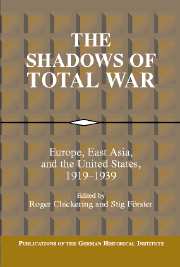Book contents
- Frontmatter
- Introduction
- Part One Reflections on the Interwar Period
- 1 The Politics of War and Peace in the 1920s and 1930s
- 2 War and Society in the 1920s and 1930s
- 3 Plans, Weapons, Doctrines: The Strategic Cultures of Interwar Europe
- Part Two Legacies of the Great War
- Part Three Visions of the Next War
- Part Four Projections and Practice
- Index
1 - The Politics of War and Peace in the 1920s and 1930s
Published online by Cambridge University Press: 05 January 2013
- Frontmatter
- Introduction
- Part One Reflections on the Interwar Period
- 1 The Politics of War and Peace in the 1920s and 1930s
- 2 War and Society in the 1920s and 1930s
- 3 Plans, Weapons, Doctrines: The Strategic Cultures of Interwar Europe
- Part Two Legacies of the Great War
- Part Three Visions of the Next War
- Part Four Projections and Practice
- Index
Summary
Two factors must be kept in mind at all times when the 1920s and 1930s are under review: the dominating memory of the “Great War” - as what we call World War I had come to be called - and the reality of continued conflict in some portions of the world. In Europe, where most of the fighting had taken place, there was hardly a family without a member who had been killed or wounded in the recent conflict; those individuals were now either conspicuously missing from the family circle or were carrying the physical scars of the fighting. And the family members who had been at the front and survived were generally careful to keep their most awful experiences to themselves; what was the point of upsetting loved ones with accounts of terrors they could neither understand nor alter? The general nature of the fighting and its horrors for participants were well enough known and needed no reciting.
No one anywhere needed to be told that it had all been terrible. Photography was sufficiently advanced by this time to enable anyone interested to obtain some appreciation of the devastation - if they had not seen it in person. Furthermore, certain new developments in the conduct of warfare had aroused horror at the time, and these continued to haunt the memory of the past and reinforce fears for the future. The introduction of poison gas and of the bombing from the air of towns far distant from the actual fighting, both originally German contributions to warfare, were feared as signs of ever more horrible features of fighting if it ever took place again.
- Type
- Chapter
- Information
- The Shadows of Total WarEurope, East Asia, and the United States, 1919–1939, pp. 23 - 34Publisher: Cambridge University PressPrint publication year: 2003



